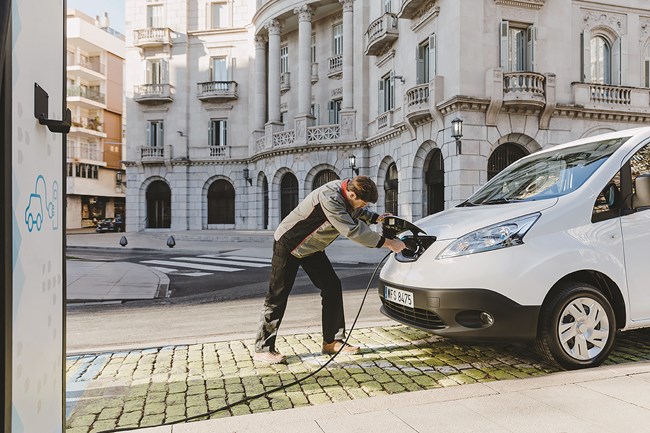- Orders open for Ineos Grenadier Commercial
- Toyota Hilux range gains new rally-inspired GR Sport II variant
- Remarketing: Pick of the bunch
- GA Commercial acquires first vans through Vanaways
- 'Luxury' tax on expensive pick-up trucks suggested
- ADVERTISEMENT FEATURE: Essential advice to avoid the van fleet ICE-berg
- ETRUX launches new Ford E-Transit Trizone
- Renault gives UK debut to Master E-Tech at CV Show
- Isuzu D-Max long-term test – Latest Report
- Isuzu D-Max V-Cross Steel Edition revealed
ADVERTISEMENT FEATURE: Study affirms digital tech catalyst for electric transport
Date: Monday, June 27, 2022
By Beverley Wise, regional director UK & Ireland for Webfleet Solutions.

Electric van registrations continue their upward trajectory, despite the supply pressures facing the UK’s LCV sector.
E-LCV take-up increased by 53% in the year to April 2022, according to figures from the Society of Motor Manufacturers and Traders (SMMT), and they now represent one in every 24 new vans hitting UK roads.
The market, however, is still playing catch-up with passenger cars – meaning more must be done in the commercial vehicle arena to accelerate van transport decarbonisation.
Sustainability leaders emphasise the importance of innovation, with tech developments integral to an e-mobility ecosystem that is helping lower the barriers to electric vehicle (EV) adoption.
Green ambitions
Research by Bridgestone and Webfleet Solutions has revealed that, as things stand, only 42% of van fleets believe their incumbent technology is sufficient to manage the environmental impact of their vehicles.
Nevertheless, carbon reduction has become their number one business priority, cited by almost half (49%), while the automation of fleet processes remains a priority for 42%. These two targets go hand-in-hand.
E-mobility insights
Connected fleet data, for example, is now underpinning planning reports that offer visibility over the typical mileages and journeys undertaken by drivers. This signals which vehicle fleets can cost-effectively switch to EV alternatives.
In ‘real world’ conditions, the published ranges of electric vans can be lower, with load, temperature, terrain and driving behaviour all affecting performance. But using the Webfleet Fleet Electrification Planning Report to draw upon daily ‘real world’ mileages, supported by criteria from road type to standstill time, analysis of an existing fleet can be simplified.
As part of this feasibility assessment, consideration should be given to the operational nature of journeys. Although EV choice is improving, fleets should pay heed to payload requirements, along with other business prerequisites, such as the need to tow civil plant or other equipment. Telematics insights can play an important role here.
What’s more, they can provide fleets with swift access to intelligence on vehicle mileage and dwell times, helping determine where vehicles spend most of their time.
By doing so, businesses can better shape their charging strategies by clearly identifying whether they need to use home, office or public charging infrastructure.
Elsewhere, telematics platforms can simplify total cost of ownership (TCO) calculations – another problem area for many van fleet operators.
According to our research, more than a third (37%) of van fleet decision-makers admit to not being confident calculating an EV fleet’s TCO.
Electric vans remain more expensive to lease or purchase upfront than equivalent petrol or diesel models, and all the while, energy prices are soaring. These factors risk deterring some fleets from grasping the nettle.
TCO, however, still tends to favour the electric vans over their fossil-fuelled counterparts, with a lower cost per mile for fuel, along with lower SMR (service, maintenance and repair) costs.
Telematics insights, generated at the touch of a button, make it easier to compare petrol and diesel vehicle running costs with actual real-world EV performance.
On the road to cost efficiency
Where electric vans have been introduced, telematics insights can help optimise operations, minimising downtime and reducing costs.
Using dedicated EV solutions, fleet managers can access information on real time battery levels and remaining driving ranges for every fleet vehicle. In addition, the location of charging points can be pinpointed by drivers, via their in-cab sat-nav devices.
Energy consumption reports analyse energy usage – in kWH, per vehicle, per day – enabling the energy performance of fleet vehicles to be compared to help identify and address inefficiencies.
Tools such as Webfleet’s Charger Connection Report also provide insights into the charging process and vehicle charge levels, helping ensure charging occurs when tariffs are most favourable and in a way that minimises battery degradation.
Although EVs tend to suffer from fewer maintenance issues, where problems occur, they can be out of commission for longer periods with repairs relating to electrical components calling for the discharging and recharging of batteries.
On-board diagnostics, malfunction alerts and connected EV health data, including battery status, relayed to managers from their electric fleets in real time using telematics platforms, can ensure preventative maintenance work is carried out in a timely manner.
Vehicle maintenance planning tools will also help fleet operators make use of real measured mileage to plan maintenance intervals.
Furthermore, the impact of harsh driving styles – including aggressive cornering, braking or speeding – on fleet maintenance costs can prove as damaging for EVs as for ICE vehicles.
Advanced solutions such as Webfleet’s OptiDrive 360 scores and profiles drivers based on performance indicators that relate to efficient, smooth and safe driving.
Actionable data has long been an important ingredient for improvements in business performance. In terms of fleets, it is fast becoming an indisputable and indispensable asset – a catalyst for success in a new era for electric transport.
0208 822 3605
View The WhatVan Digital Edition


